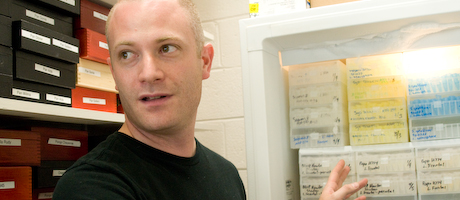By Julia Parmley
Brains of tigers, elephants—and lots of monkeys— are considered office supplies for Associate Professor of Anthropology Chet Sherwood and his staff in GW’s Laboratory for Evolutionary Neuroanatomy. One of only a small number of laboratories in the world to directly investigate brain evolution in mammals, the laboratory uses high-powered tools to collect information on the variations in the brain architecture in mammals.
“We examine the brains of primates and other mammals and compare them with human brains in an effort to better understand what is special about human neurobiology,” says Dr. Sherwood. “We also analyze differences in brain anatomy and function, such as cognitive process and language, to understand how the human brain has evolved.”
The team is exploring species differences in composition and distribution of aspects of the cerebral cortex; neurons, or nerve cells; glial cells, which provide support and protection for neurons; neurotransmitters in the nervous system; and synaptic organization (connections between neurons and other cells) in the brain.
The research team includes Dr. Sherwood, post-doctoral scientists Muhammad A. Spocter, Tanya Duka, senior research assistant Cheryl Stimpson, and a rotating group of graduate and undergraduate students from countries as far afield as South Africa, Italy and England.
The stars of the show—nearly a hundred mammal brains from around the world—are held in two large white freezers in the laboratory in Ross Hall. The team uses MRI scans to document the form and structure of these diverse brains. Then they slice and stain the brain tissue to investigate cell bodies and nerve fibers under the microscope. In addition, Dr. Sherwood and his team examine brain asymmetry and lateralization of brain function (function on the left or right side of the brain) in chimpanzees and how they relate to human brain evolution.
“We look at the brain as a whole but also at a cellular level, and these different levels help us determine the link between the brain’s anatomical structure and behavior,” says Dr. Sherwood. “They can also shed light on functions such as social cognition and fine motor control that seem to have been modified in human evolution.”
Dr. Sherwood began the laboratory as an assistant professor at Kent State University in 2003 and brought it to GW in 2006 as part of the Mind, Brain, Evolution cluster in GW’s Mind-Brain Institute. While study of human behavior in psychology and examination of fossils in anthropology have revealed a significant amount about human evolution, Dr. Sherwood says that his kind of research—an in-depth scrutiny of brain structure and development using actual brains — is necessary to comprehend how humans function the way they do.
“So much of what makes us human happens early in our life,” he says. “We want to detail the fine anatomical differences in the neocortex between humans and other species and look at how it relates to behavior. GW has been very supportive of what we are doing.”
An area of science that is “relatively untapped,” Dr. Sherwood believes the study of evolutionary neuroanatomy is critical to understanding what makes us human—and, he says, it happens to be a lot of fun as well. “We are addressing the fundamental questions of human nature and are trying to understand what makes our species unique,” he says. “What can be more interesting than that?”


